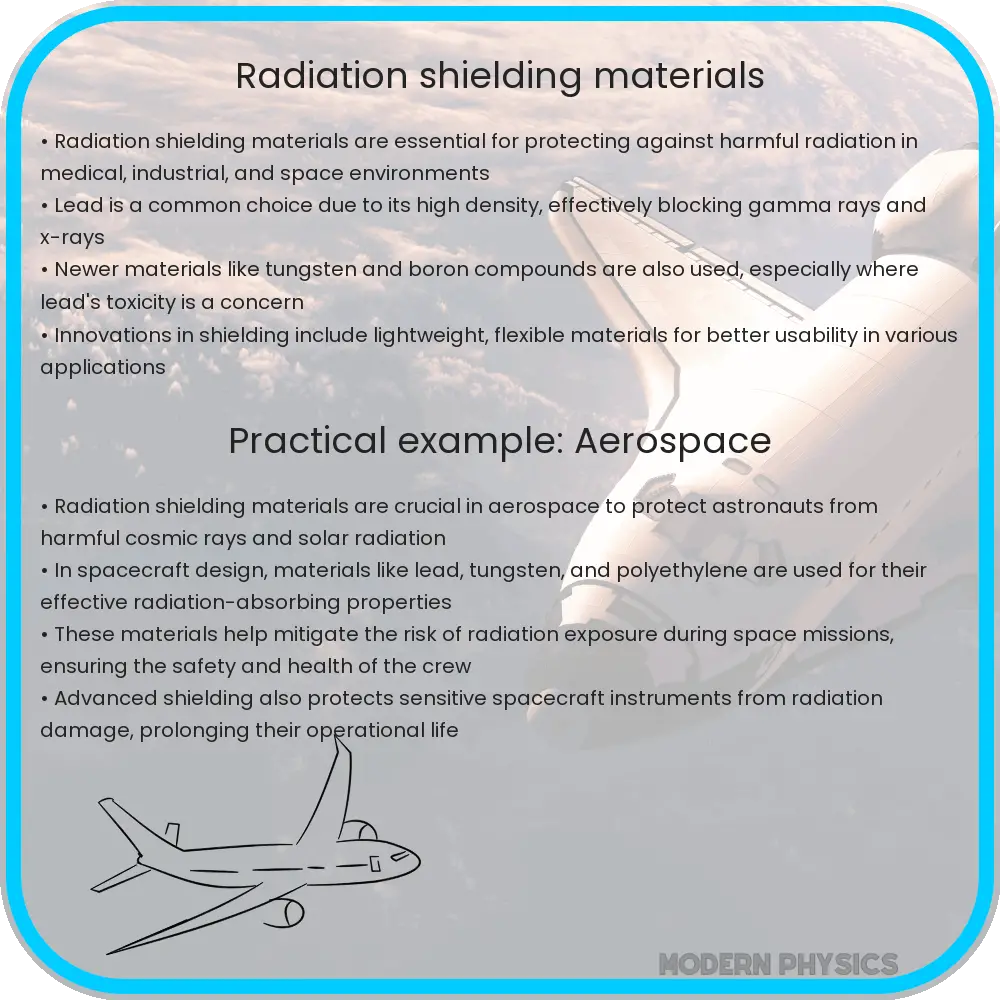Learn about the various materials used for radiation shielding, their effectiveness against different types of radiation, and the latest innovations in the field.

Introduction to Radiation Shielding Materials
Radiation is an integral part of our universe, used beneficially in medical treatments, scientific research, and power generation. However, excessive exposure to certain types of radiation can be harmful to living organisms, necessitating effective shielding methods. In this article, we explore the various materials used for radiation shielding, assessing their safety, efficiency, and the latest innovations in the field.
The Science of Radiation Shielding
Radiation shielding refers to the practice of using materials to protect against the harmful effects of radiation. This involves the absorption, reflection, or scattering of radiation to reduce its intensity. The effectiveness of a shielding material depends on factors such as the type of radiation (alpha, beta, gamma, neutron), its energy, and the properties of the shielding material.
- Alpha particles are heavy and carry a positive charge. They can be stopped by a sheet of paper or even the outer layers of human skin.
- Beta particles are lighter and carry either a negative or positive charge. Materials like plastic or aluminum are effective at stopping beta radiation.
- Gamma rays are highly penetrating electromagnetic radiation. Dense materials like lead or thick layers of concrete are required to attenuate these rays effectively.
- Neutrons, uncharged particles, are best shielded by materials that contain hydrogen, such as water or polyethylene, which slow down and capture neutrons.
Key Materials Used in Radiation Shielding
When selecting a radiation shielding material, physical properties, radiation type, material cost, and ecological impact are considered. Here are some commonly used materials:
- Lead: Known for its high density, lead is a traditional choice for gamma and X-ray shielding. However, its toxicity has led to increased regulations and the search for safer alternatives.
- Concrete: Widely used in nuclear facilities due to its effectiveness in shielding both neutrons and gamma rays. Its composition can be adjusted by adding materials like boron to enhance neutron absorption.
- Water: Due to its hydrogen content, water is an excellent neutrons absorber and is often used in nuclear reactors’ cooling pools for storage and shielding.
- Polymers: Newer materials like high-density plastics augmented with metals such as boron or hydrogen-rich compounds are becoming popular for their effectiveness, lighter weight, and less environmental impact than lead.
Innovations in Radiation Shielding
Researchers are constantly seeking new materials and technologies to provide effective and safe radiation shielding. Innovations include the use of nanomaterials, recycling of industrial waste into protective barriers, and development of flexible, lightweight composite materials for better handling and usability.
One promising area is the incorporation of nanotechnology into traditional shielding materials. Nanoparticles can enhance a material’s structural properties and improve its radiation-absorbing capabilities. For example, adding nano-sized boron carbide particles to materials traditionally used for neutron shielding can significantly increase their effectiveness.
Efficiency and Safety Challenges
Despite the variety of materials available, several challenges persist in radiation shielding. Ensuring safety while maintaining cost-effectiveness remains a primary concern, particularly in medical and industrial environments. Moreover, the ecological impact of using certain materials, such as lead, necessitates ongoing research into sustainable alternatives.
Additionally, the physical properties of shielding materials, such as thickness and durability, can affect their practical application. Innovations aimed at reducing weight and enhancing flexibility without compromising shield strength are key areas of focus for researchers and engineers.
Applications in Different Industries
Radiation shielding materials are applied across various sectors, significantly impacting public health and safety. In medical settings, these materials protect both patients and healthcare workers from unnecessary exposure during X-ray imaging and radiation therapy. In space exploration, shielding protects astronauts from cosmic radiation, a critical consideration for extended missions. Additionally, the energy sector relies on robust radiation shielding to ensure the safe operation of nuclear reactors.
- Healthcare: Portable shields and protective garments use advanced materials to safeguard against X-rays.
- Aerospace: Lightweight composite shielding materials are critical for protecting space vehicles and habitats from solar and cosmic radiation.
- Nuclear Energy: Efficient and durable materials such as reinforced concrete and water-based shields ensure the containment of radiation within nuclear plants.
Future Outlook
The future of radiation shielding is leaning towards materials that not only provide superior protection but are also sustainable and cost-effective. Innovations such as the use of recycled materials, improved composites, and smart shielding systems that adapt to different radiation levels are likely to dominate the field. The integration of machine learning tools to simulate and predict the performance of new shielding materials could also accelerate development in this important area.
Conclusion
To sum up, the field of radiation shielding is as diverse as it is critical. From healthcare to space exploration, effective shielding remains a cornerstone of safety and operational success. While traditional materials like lead and concrete continue to play a significant role, emerging technologies and the push towards greener alternatives are shaping the future of how we protect ourselves from the invisible yet palpable threat of radiation. As research progresses, the adoption of innovative shielding strategies will play a pivotal role in safeguarding human health and advancing technological frontiers in environments exposed to radiation.
